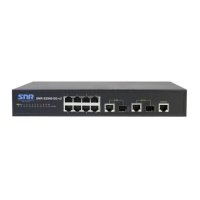SNR S2940-8G-v2 Switch Configuration Guide
Layer 3 Management Configuration
2. Configure VLAN interface description
Command Explanation
VLAN Interface Mode
description <text>
no description
Configure the description information of VLAN interface.
The no command will cancel the description information of
VLAN interface.
29.2 IP Configuration
29.2.1 Introduction to IPv4, IPv6
IPv4 is the current version of global universal Internet protocol. The practice has proved that
IPv4 is simple, flexible, open, stable, strong and easy to implement while collaborating well with
various protocols of upper and lower layers. Although IPv4 almost has not been changed since
it was established in 1980's, it has kept growing to the current global scale with the promotion of
Internet. However, as Internet infrastructure and Internet application services continue boosting,
IPv4 has shown its deficiency when facing the present scale and complexity of Internet.
IPv6 refers to the sixth version of Internet protocol which is the next generation Internet protocol
designed by IETF to replace the current Internet protocol version 4 (IPv4). IPv6 was specially
developed to make up the shortages of IPv4 addresses so that Internet can develop further.
The most important problem IPv6 has solved is to add the amount of IP addresses. IPv4
addresses have nearly run out, whereas the amount of Internet users has been increasing in ge-
ometric series. With the greatly and continuously boosting of Internet services and application
devices (Home and Small Office Network, IP phone and Wireless Service Information Terminal
which make use of Internet,) which require IP addresses, the supply of IP addresses turns out
to be more and more tense. People have been working on the problem of shortage of IPv4 ad-
dresses for a long time by introducing various technologies to prolong the lifespan of existing IPv4
infrastructure, including Network Address Translation(NAT for short), and Classless Inter-Domain
Routing(CIDR for short), etc.
Although the combination of CIDR, NAT and private addressing has temporarily mitigated the
problem of IPv4 address space shortage, NAT technology has disrupted the end-to-end model
which is the original intention of IP design by making it necessary for router devices that serve as
network intermediate nodes to maintain every connection status which increases network delay
greatly and decreases network performance. Moreover, the translation of network data packet
addresses baffles the end-to-end network security check, IPSec authentication header is such an
example.
Therefore, in order to solve all kinds of problems existing in IPv4 comprehensively, the next
generation Internet Protocol IPv6 designed by IETF has become the only feasible solution at
present.
First of all, the 128 bits addressing scheme of IPv6 Protocol can guarantee to provide enough
globally unique IP addresses for global IP network nodes in the range of time and space. Moreover,
besides increasing address space, IPv6 also enhanced many other essential designs of IPv4.
Hierarchical addressing scheme facilitates Route Aggregation, effectively reduces route table
entries and enhances the efficiency and expansibility of routing and data packet processing.
The header design of IPv6 is more efficient compared with IPv4. It has less data fields and
200

